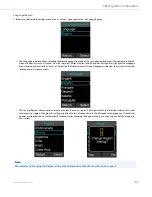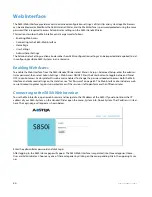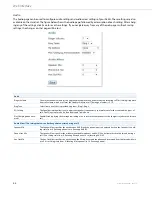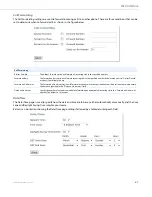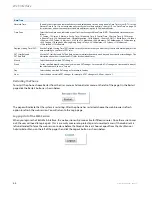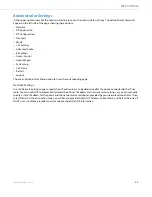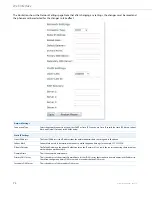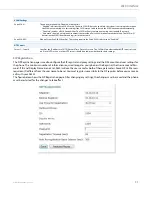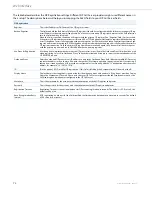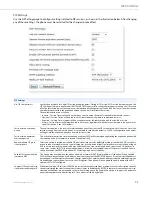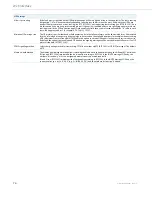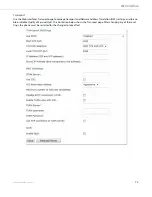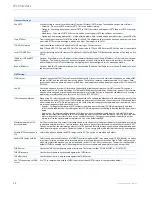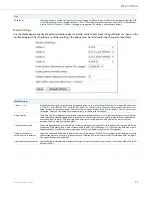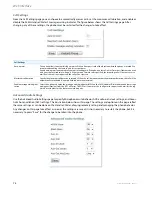
Web Interface
76
41-001516-00 REV00 – 06.2013
Transport Settings
Use SRTP
Use this setting to control Secure Real-time Transport Protocol (SRTP) usage. The available options are as follows:
•
Disabled – Do not use SRTP; always use RTP. This is the default setting.
•
Optional – Use the optional disposition for SRTP in SDP. If the remote end supports SRTP, then use SRTP; otherwise,
use RTP.
•
Mandatory – Force use of SRTP. If the remote end does not support SRTP, the call does not connect.
•
Optional by duplicating media offer – Use duplicated media, both secured and unsecured versions, in the SDP offer.
Start RTP Port
This is the base port number for RTP. The default is 4000. RTP is originated and received on even port numbers, and the
associated RTCP uses the next higher odd port number. The range is 0 to 65535.
TCP/UDP Selection
Select the transport that will be enabled for SIP messages. The options are:
Both TCP and UDP, TCP Only, and UDP Only. The default is Both TCP and UDP. Note that UDP will be used if it is available.
Local TCP/UDP Port
Specify the local port for SIP transport. The default is 5060 for UDP and TCP. (Both use the same port). The range is 0 to
65535.
IP Address (SIP and RTP
address)
Optional. If specified, use this IP address (or hostname) as the advertised SIP and RTP address of this transport (the pub-
lic address). The IP address does not have to correspond with one of the local host network interfaces; it may be the
public IP address of a NAT router where port mappings have been configured for the phone application.
Bound IP Address
Optional. Bind the SIP and media transports to the specified IP address. The IP address must be an IP address of one of
the host network interfaces.
NAT Settings
STUN Server
Optional. Specify the STUN (Session Traversal Utilities for NAT) server to use to determine if the phone is behind a NAT,
the type of NAT, and the public address of the phone. The field can contain a comma separated list of servers. Each
server can be a domain name, host name, or IP address, and it may contain an optional port number. (For STUN see IETF
RFC 5389).
Use ICE
Check this option to use the ICE (Interactive Connectivity Establishment) protocol for NAT traversal. This option is
checked by default. ICE takes advantage of STUN and TURN to identify candidates (IP addresses and ports) for commu-
nication, evaluating and prioritizing the candidate pairs to select the best route. Expensive candidates, such as using a
media relay, are selected only as a last resort. (For ICE see IETF RFC 5245).
ICE Nomination Method
When using ICE, select the preferred ICE Nomination Method. To validate candidate pairs (IP addresses and ports for the
local and remote nodes), S850i sends STUN binding requests as part of the media connectivity tests. When a candidate
is nominated for use, a STUN binding request is sent with a flag indicating that the candidate pair is nominated. There
are two nomination methods that can be used:
•
Regular – For Regular Nomination, S850i validates candidate pairs with initial STUN binding requests, and then
selects a valid candidate pair by sending another STUN binding request with a flag indicating that the pair is nomi-
nated.
•
Aggressive – For Aggressive Nomination, S850i doesn’t wait to set the nominated flag in a second STUN binding
request, but rather sets the flag in the STUN binding requests for all of the candidate pairs. The ICE processing com-
pletes when the first pair successfully passes connectivity checks. The aggressive method is faster but does not
always result in the optimal path being selected. This is the default method.
Maximum number of ICE
host candidates
An ICE host candidate is an actual local transport address in the host. Host transport addresses are obtained by binding
to attached network interfaces. These interfaces include both physical interfaces and virtual interfaces such as VPN.
This option specifies the maximum number of local ICE host candidates that may be used in evaluating candidate pairs
when determining the best route. The default value is -1 or an empty field, which indicates that there is no maximum.
Disable RTCP component in
ICE
Select this option to disable the RTCP component in ICE. The option is unchecked by default.
Enable TURN relay with ICE
Select this option to enable the use of a TURN (Traversal Using Relay NAT) relay when using ICE. A TURN relay is a media
relay server residing on the public internet which can relay media data packet between clients. TURN relays are used
when other preferred mechanisms are not available, such as STUN or direct connectivity. The option is unchecked by
default. If TURN is enabled, the TURN settings below (server, username and password) must also be specified.
TURN Server
Specify the TURN server domain name or hostname. The format is either "DOMAIN:PORT" or "HOST:PORT"
TURN Username
Specify the username to authenticate against the TURN server.
TURN Password
Specify the password to authenticate against the TURN server.
Use TCP connection to TURN
server
Use TCP to communicate with the TURN server rather than UDP. This option is unchecked by default.


